Fleas
Flea is the common name for insects of the order Siphonaptera which are wingless insects with mouthparts adapted for piercing skin and sucking blood. Fleas are external parasites, living by hematophagy off the blood of mammals (including humans) and birds.
Fleas are small (1/16 to 1/8-inch (1.5 to 3.3 mm) long), agile, usually dark colored (for example, the reddish-brown of the cat flea), wingless insects with tube-like mouth-parts adapted to feeding on the blood of their hosts. Their legs are long, the hind pair well adapted for jumping (vertically up to seven inches (18 cm); horizontally thirteen inches (33 cm) - around 200 times their own body length, making the flea one of the best jumpers of all known animals (in comparison to body size), second only to the froghopper.
Fleas attack a wide variety of warm-blooded vertebrates including dogs, cats, humans, chickens, rabbits, squirrels, rats, ferrets, and mice. Fleas are a nuisance to their hosts, causing an itching sensation which in turn may result in the host attempting to remove the pest by biting, pecking, scratching, etc. the vicinity of the parasite. Fleas are not simply a source of annoyance, however. Some people and animals suffer allergic reactions to flea saliva resulting in rashes. Flea bites generally result in the formation of a slightly-raised swollen itching spot with a single puncture point at the center (similar to a mosquito sting). The bites often appear in clusters or lines of two bites, and can remain itchy and inflamed for up to several weeks afterwards. Fleas can also lead to hair loss as a result of frequent scratching and biting by the animal, and can cause anemia in extreme cases.
Human Flea
Pulex irritans
The American cockroach (Periplaneta americana), also known as the Palmetto Bug or Waterbug, particularly in thesouthern United States, is the largest species of common cockroach, and often considered a pest.
American cockroach adults grow to an average length of around and about tall. They are reddish brown and have a yellowish margin on the body region behind the head. Immature cockroaches resemble adults except that they are wingless.
The insect can travel quickly, often darting out of sight when someone enters a room, and can fit into small cracks and under doors despite its fairly large size. It is considered one of the fastest running insects.
Appearance

• Fleas are black to brownish–black wingless insects.
• Adult fleas are 1 to 4 mm long.
• They possess a long, fine proboscis which is used to pierce the skin of their host to feed on their blood.
• They have a characteristic jumping movement.
Lifecycle
• A female flea will lay 4 to 8 eggs after each blood meal, and can usually lay several hundred eggs during her adult life.
• The smooth, oval light–coloured eggs measuring around 0.5 mm long, are deposited on, but not firmly attached to, the body, bedding, or nest of the host.
• The adult generally emerges in a week or two after completing a larval and pupal stage, but under unfavourable conditions, the pupal period may be as long as a year.
Habits
• Fleas most often bite people around the legs and ankles, usually with 2 or 3 bites in a row. The bites are felt immediately and can be sore for as much as a week.
• Since they move from one host species to another, they present a risk of transmitting disease.
• Pulex irritans is also a vector of Yersinia pestis (plague).
• Human fleas can also be found on animals such as dogs, rats, pigs, deer and foxes.
Cat Flea
Ctenocephalides felis
Appearance
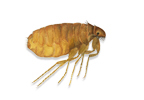
• 2–3mm long wingless ticks.
• Flattened from side to side.
• Have long legs enabling them to jump.
• They have both genal and pronotal combs (ctenidia), differentiating them from most other fleas of domestic animals.
Lifecycle
• Fleas pass through four stages: eggs, larva, pupa, adult. The eggs are small and white.
• These stages combined vary from two weeks to eight months.
• The adult flea is awakened by the detection of vibration of pet or human movement, pressure, heat, noise, or carbon dioxide for potential blood meals.
• A cat flea cannot complete is life–cycle feeding only on human blood.
Habits
• These fleas are often unable to determine whether a host is suitable until it has been bitten. If it is deemed unsuitable, the flea soon drops off.
• These fleas nest where the host is in its usual resting place, for example the cat basket. This is where the young drop to mature.
Dog Flea
Ctenocephalides canis
Appearance
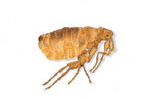
• Adult is brownish black in colour, but appear reddish–black after a blood meal.
• Adult fleas are 1 to 4 mm long.
• The legless larva is off–white and measures up to 5 mm long.
Lifecycle
• The fleas go through a four–stage life cycle: eggs, larvae, pupae, adult.
• The larvae are longer than the adults and feed on particles of dry blood, excrement, and organic substances collected in the infested premises.
• The body is laterally flattened, which allows it to move easily through an animal’s fur. Spines project backwards from the body of the flea, which help it to hold onto the host animal during grooming.
Habits
• Adults feed on the blood of dogs and cats, and they occasionally bite humans.
• The Dog Flea is a vector of the Dog Tapeworm, Dipylidium caninum, which can also affect man.
• As they can jump approximately 6 inches, they can move from host to host. They can also infest garden lawns.
• A flea infestation can affect the general well–being of your pet, cause itching, redness, hair loss, severe skin infections or allergies to flea saliva.
Brown Dog Tick
Rhipicephalus sanguineus
Appearance
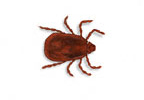
• Reddish–brown colour.
• Elongated body shape.
Lifecycle
• The dog tick is a 3–host tick, so must change host between the 3 stages of growth (larva, nymph and adult).
• They require only three blood meals to complete development; once at each growth stage.
Habits
• It is found on dogs, in kennels and houses, and occasionally on wildlife, but rarely on humans.
• In warm areas several generations of tick can be expected per year.
• The most common places for attachment on dogs are those areas the animal is unable to groom easily.
Bird Flea
Ceratophyllus gallinae
Appearance
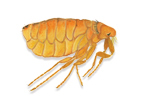
• Adult fleas are generally brownish in colour, and 1–8mm long.
• The eyes as well as the antennae are apparent. Their mouthparts are well adapted for piercing skin and sucking blood and project downwards from the head.
• This species is the most common bird flea, the hen flea.
Lifecycle
• Bird fleas can only live for a short time indoors and only in nests.
• They breed during the nesting period when the host and/or young are available for regular blood meals.
Habits
• Adult bird fleas live in bird nests. When the birds move from the nest, the adult fleas must find a new host.
• If the nest is reused, the pupae will hatch,mate and continue the breeding cycle.
• Bird fleas can multiply enormously in hen houses, breeders, batteries etc.
Bird Mite
Dermanyssus gallinae
Appearance
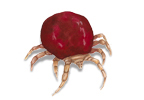
• 0.6 – 0.7mm long.
• Soft yellow/green body and eight legs.
• When fully fed the body appears bright red.
Lifecycle
• Egg to adult in 7 days (under favourable conditions).
• Adult lives approximately 90 days.
Habits
• Feed on birds blood.
• Favours warm, moist conditions.
• Common in birds nests and poultry houses.
• Capable of reducing bird egg–laying efficiency. In severe cases it may kill young, sick or old birds.
• In homes, bird mites may bite people in search of food.


